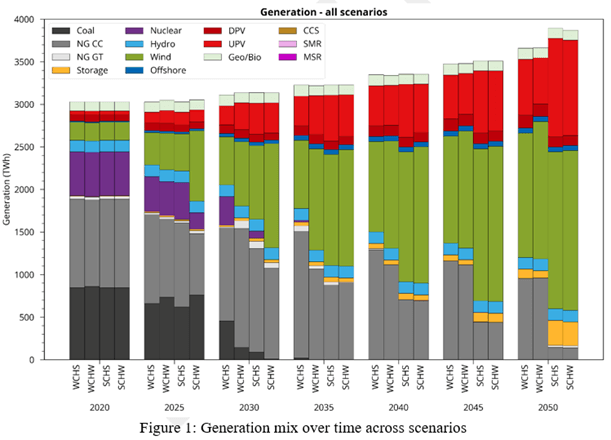New studies find grid modernization accelerates cost-effective renewable energy growth
Renewable energy has begun to dominate new electric generation capacity additions over the past several years for a variety of reasons– plummeting technology costs, increasing efficiency, and corresponding demand from the public and private sector, among others. However, to fully realize a 21st century clean energy economy we need to update our electric system to meet today’s needs, modernize the grid, and expand access to renewables through transmission infrastructure. Now, two new studies show how transmission investments can accelerate clean energy growth while saving money for American families and businesses.
Transmission investments benefit the economy and the environment
This week, Americans for a Clean Energy Grid (ACEG) released Consumer, Employment, and Environmental Benefits of Electricity Transmission Expansion in the Eastern U.S. The paper details the reliability of a very high wind, solar, and storage scenario within the Eastern Interconnect and the benefits such a scenario would deliver to consumers. The Eastern Interconnection is one of the two major grid interconnections in the U.S., comprised of 36 balancing authorities across most states East of the Rocky Mountains (grid interconnection map here).
The study finds world-class solar and wind resources are often stranded in remote areas where the power grid is weak to nonexistent. Policy barriers in how the U.S. plans, pays for, and permits transmission are blocking private investment that would modernize the power grid. Breaking that logjam would unleash up to $7.8 trillion in investment in rural America, create over 6 million net new domestic jobs, and save consumers over $100 billion, all while providing Americans with cleaner air.
The study is groundbreaking in that it’s one of the first to evaluate how wind, solar, storage, and transmission each play essential, unique, and complementary roles in providing consumers with reliable and affordable electricity. This analysis shows that by investing in transmission, the Eastern U.S. can access low-cost renewable energy to:
- Cost-effectively reduce electric sector CO2 emissions by 65 percent by 2035, and by over 95 percent by 2050.
- Reliably obtain over 80 percent of its electricity from wind and solar by 2050.
- Decrease the average electric bill rate by more than one-third, from over 9 cents/kilowatt hour (kWh) today to around 6 cents/ kWh by 2050, saving a typical household more than $300 per year. These savings are broadly shared by all consumers across the region.
- The cost of transmission accounted for only 3.6 percent of total electricity costs on average in the strong carbon reduction cases. Transmission yielded savings many times greater than that by providing access to low-cost renewable resources and increasing the overall efficiency of the power system.
- Create over 6 million net new jobs, increasing electric sector employment more than five-fold from around 1.3 million to over 7.5 million jobs by 2050. The new jobs are broadly spread across the Eastern U.S. Transmission investment alone drives over 1.5 million new jobs.
- Deliver reliable power by meeting electricity demand in every five-minute period of the year, even with wind and solar providing 82 percent of electricity in 2050 in the strong carbon policy cases.
The following chart shows how all four transmission scenarios studied result in rapid growth of wind and solar energy (in red, DPV and UPV, for distributed and utility scale, respectively).

Examining the benefits of greater connectivity by bridging the seams
The U.S. Department of Energy (DOE) also released a long-awaited report this week, The Value of Increased HVDC Capacity Between Eastern and Western U.S. Grids: The Interconnections Seam Study. The study is the culmination of a more than two year analysis of electricity grid optimization for most of the U.S.
The three major components of the U.S. power system—the Western Interconnection, the Eastern Interconnection, and the Electric Reliability Council of Texas—operate almost independently of each other. Very little electricity is transferred between the interconnections due to limited transfer capacity. DOE’s new study quantifies the costs and benefits of strengthening the connections (or seams) between the Eastern and Western Interconnections, which would encourage efficient development and utilization of U.S. energy resources. Depicted in the following chart, the study overlays population centers along with the concentrations of all electricity generation sources, modeling different “seams scenarios” where strengthened grid interconnections can provide optimal system benefits.

Key Findings
The study’s key findings include:
- The power system can balance generation and load. Additional transmission enabled lower total installed capacities, especially in the High VG scenario.
- There are substantial positive benefit-cost ratios for increasing the transfer capability between the interconnections.
- Cross-seam transmission has a substantial impact on the location of wind and solar generation additions. Wind shifts to the Eastern Interconnection and solar to the Western Interconnection.
- Additional benefits and costs may exist (e.g., frequency response and resilience to extreme events).
The DOE landing page for the report is here with more high-level data and charts. A preliminary pre-publication draft of the full report is available here, plus a PowerPoint at this link.
Both studies underscore a critical reality—our electric system needs to adapt along with our generation mix, which is becoming cleaner and consists of ever-more renewable resources. We can realize substantial returns on investments in transmission and grid modernization in the form of more affordable, reliable, clean electricity and economy-strengthening job creation. That’s the power of a 21st century clean energy economy.





